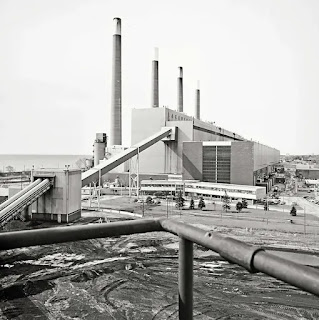 |
| Derrick Mealiffe from Toronto, Canada, CC BY-SA 2.0, via Wikimedia Commons |
John Vincent posted three photos with the comment: "A builders plate from one of the turbine units in the now defunct Lakview GS of Ontario Hydro West of Toronto. The overall picture of the station with me on the end of the collier dock was taken in 1968 when the plant was still under construction. The turbine is unit 3 (300MW as all the other 7 units were) under test in this 1967 picture. The plant was torn down and the stacks blown in 2014."
[I changed the order of the photos.]
Joe Cicchii: 3600 rpm!! [That is significant because it was made in England, which uses 50hz instead of 60hz.]
Brad Piatt: Odd crossover arrangement.
John Vincent: Brad Piatt Double flow HP, single flow IP, with its exhaust discharged to two double flow LP spindles.
Brad Piatt: John Vincent Yes. The typical design would only have two penetrations to the IP shell and two crossover pipes that reduce in size after the first LP.
Gary Olix: English Imports? Coulda got em in Schenectady 🇺🇸 USA
John Vincent: Gary Olix Yup, English imports. We had four Parsons units that were built right in Toronto. It did create problems, as the UK system is 50 cycles, ours, of course, is 60 cycles. They tried to run a 50 cycle machine to produce 60 cycle power. This got the machines into the start of second harmonics, which caused no end of problems. The AEI tech was in for monthe doing test runs and trying to figure how to get the bounce out of them. The solution was several tons of weights hanging on the generator bells on each end.
 |
| 2 |
 |
| 1 |
 |
| 3 |
Ca. 2001 they reduced the NOx emissions of four of the units by 50%. "Lakeview Station Units 1, 2, 5 and 6 are 300 MWe, B&W split furnace, radiant boilers firing bituminous coal. Units 1 & 2 have 24 burners and Units 5 & 6 have 18 burners all located on the front wall. The original B&W register style burners were used as a basis to reduce NOx emissions to the maximum amount possible by means of burner modifications using RJM’s low NOx burner components." [ResearchGate]
Five of the several photos taken by Peter MacCallum in 2005.
 |
| a |
 |
| b [These are the balls used in the mill below to pulverize the coal.] |
 |
| c |
 |
| d |
 |
| e |
 |
| One of many images taken by Kendall Anderson [This page also includes a video of the demolition of the "Four Sisters," that is, the smokestacks. Considering that the bangs of the blasts are delayed by the speed of sound, it is interesting how long it takes for the stacks to start falling after we hear the bangs.] |
 |
| InfrastructureOntario The developer will transfer 67-acres of remediated waterfront land from the 177 acre site to the City of Mississauga. |
Actually, the land for the park is landfill built with the rubble from the demolition of the power plant. The developers spin the rubble as a donation. In fact, I'll bet the city did them a big favor to allow them to dump the rubble so close to the site. At least building rubble would be clean. I wonder what happened to the dirt that was under the coal pile.
 |
| TheGlobeAndMail "Lakeview Village will include more than 8,000 homes, which will house up to 20,000 people, as well as 1.8 million square feet of office space and 200,000 square feet of retail space, with an estimated 9,000 people working in the area when it’s done." [It will be interesting what they do about the roads feeding into this development. Chicago allows developers to turn the local streets into gridlock. I've got caught in gridlock three times, and I now avoid visiting Chicago.] |
 |
| Satellite |
Hopefully, the ash pond has been properly sealed.
The satellite image above appears to be Jun 2019. They have made more land for the park.
Here is the goal.
The satellite image above appears to be Jun 2019. They have made more land for the park.
 |
| Jun 2002 |
Here is the goal.
 |
| TheStar |

No comments:
Post a Comment